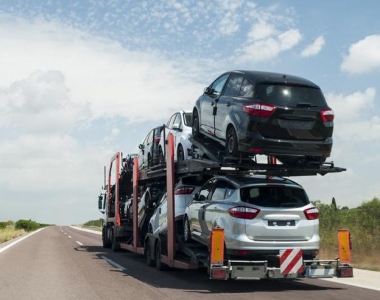Everyone shipping a car wants their vehicle to arrive at its destination as quickly, conveniently, and safely as possible. Door-to-door shipping is one of the ways in which drivers can maximize their auto transport service’s speed, convenience, and even safety—but these perks come with an added cost. Our guide below will evaluate how door-to-door car shipping differs from terminal-to-terminal delivery, along with the former’s pros and cons, so you can determine whether the extra cost makes sense for you. While more people, on average, ship their vehicle with door-to-door transport—terminal-to-terminal may be a better fit, so keep reading to find your ideal option.
How Door-to-Door Car Shipping Differs From Terminal-to-Terminal
Door-to-door shipping involves a customer choosing a pickup and drop-off point for their car’s transport. Locations for door-to-door shipping typically consist of a person’s home, office, or another convenient site. Alternatively, terminal-to-terminal auto transport includes customers dropping off and picking up their vehicles at specified terminal areas. Common examples of terminals are auto transport terminals, regional storage facilities, depots, and parking lots or yards. Terminal-to-terminal shipping is naturally less convenient since the customer is responsible for drop-off, waiting for a carrier at a facility, and retrieval instead of the transport company.
Let’s examine the pros and cons of door-to-door shipping in more detail to help you better determine which is the proper fit for your needs.
Pros of Door-To-Door Shipping
Door-to-door vehicle shipping is generally faster than its terminal-to-terminal counterpart, which is part of why the service holds a higher average cost. The expedited nature of door-to-door auto transport primarily stems from the more direct and immediate pickup and delivery.
As previously mentioned, you can specify the exact locations where you’d like a door-to-door service to pick up and drop off your car to better fit your itinerary. In addition to choosing pickup and drop-off locations, door-to-door customers can often coordinate the times of these exchanges to achieve more control over the route. Door-to-door auto transport usually involves a customer receiving a dedicated representative who provides direct communication throughout the shipping process for added support.
No driver wants to go through the steps of booking and shipping their vehicle only to have their car arrive with damages. The more handling your vehicle experiences during transport, the higher the likelihood of damage. Door-to-door shipping mitigates your chances of vehicle damage since there are fewer stops and handling than terminal-to-terminal service, which often includes more transfers and possibly storage periods. Additionally, enclosed carrier transport services are most commonly offered as door-to-door shipping, given their higher average cost.
Cons of Door-To-Door Shipping
The primary downside of door-to-door shipping is that it always costs more than terminal-to-terminal. Most industry sources concur that door-to-door auto transport runs up to 30% more than its terminal-to-terminal counterpart since the carrier travels longer distances and can spend more time in traffic, especially in urban areas, to facilitate direct pickups and drop-offs. While a carrier may not have to spend a lot of time in traffic to pick up or drop off a car in a more remote area, these locations tend to require more time from a transporter since the most in-demand routes are in urban regions or off major highways cities.
There are some rarer instances where a vehicle shipping company may need to use an alternate nearby delivery location if direct access with the preferred pickup or drop-off point isn’t feasible, slightly reducing the service’s convenience. This situation may occur if the carrier’s size doesn’t match a pickup point’s local road restrictions, like narrow streets, low-hanging trees, tight turns, or limited parking. Open carriers tend to be larger than enclosed ones since they’re the most affordable option, so drivers opting for them are more likely to encounter accessibility issues.
When Is Door-To-Door Shipping Worth It?
Your schedule requirements, route distance, and vehicle value are three primary factors you should weigh to determine whether door-to-door car shipping is worth the extra cost. Regarding scheduling, terminals operate during fixed business hours that may conflict with your calendar, with evening and weekend closings being common obstacles. Your car may also have to sit at a terminal waiting for the next available carrier after drop-off. While a door-to-door service often won’t give you a specific pickup or delivery time, you’ll typically receive a scheduling window for a more streamlined process.
If you’re shipping a car to another state or shipping a car across country, especially one of higher value, door-to-door shipping is often advisable to reduce any likelihood of damage from a terminal-to-terminal service’s additional handling. Still, terminal-to-terminal may be better if you prioritize savings over convenience, flexible drop-off or pickup windows, or live in a remote area.
Door-to-Door Car Shipping FAQ
Check out some of the most frequently asked questions about door-to-door car shipping below to evaluate whether the service meets your personal needs.
Can I Ship a Non-Running Vehicle With Door-to-Door Service?
Yes, you can often schedule door-to-door delivery for a non-running vehicle. However, the process differs from shipping a running car, requiring specialized equipment like winches, liftgates, or forklifts. Informing the company you’re booking with of your non-running car and its specific defects is essential to facilitate these procedures successfully. Due to the mentioned considerations, shipping a non-running vehicle generally costs more than transporting a running car and may take longer to schedule with fewer available carriers.
Are There Any Differences in Preparing a Car for Door-To-Door Shipping vs. Terminal-To-Terminal?
Preparing your car for door-to-door shipping is essentially the same as terminal-to-terminal preparation. Other than driving your vehicle to a terminal, the key difference in preparation for these two services is that you may not be present for a carrier’s vehicle condition report during terminal-to-terminal drop-off, whereas you will with door-to-door drop-offs. Not being present during this time can impact your ability to verify and document your car’s condition at the exact moment it changes hands, which may prove vital if the need for an insurance damage claim arises.
Is My Vehicle Insured During Door-to-Door Shipping?
While federal law doesn’t require auto transport companies to offer cargo insurance covering damage to customer vehicles, it’s typically a standard practice among carriers. Additionally, most transporters will offer cargo insurance coverage upgrades, which may be necessary for shipping more expensive vehicles. Enclosed door-to-door shipping carriers tend to provide higher standard levels of cargo insurance since they often transport higher-value cars like luxury or classic models.



